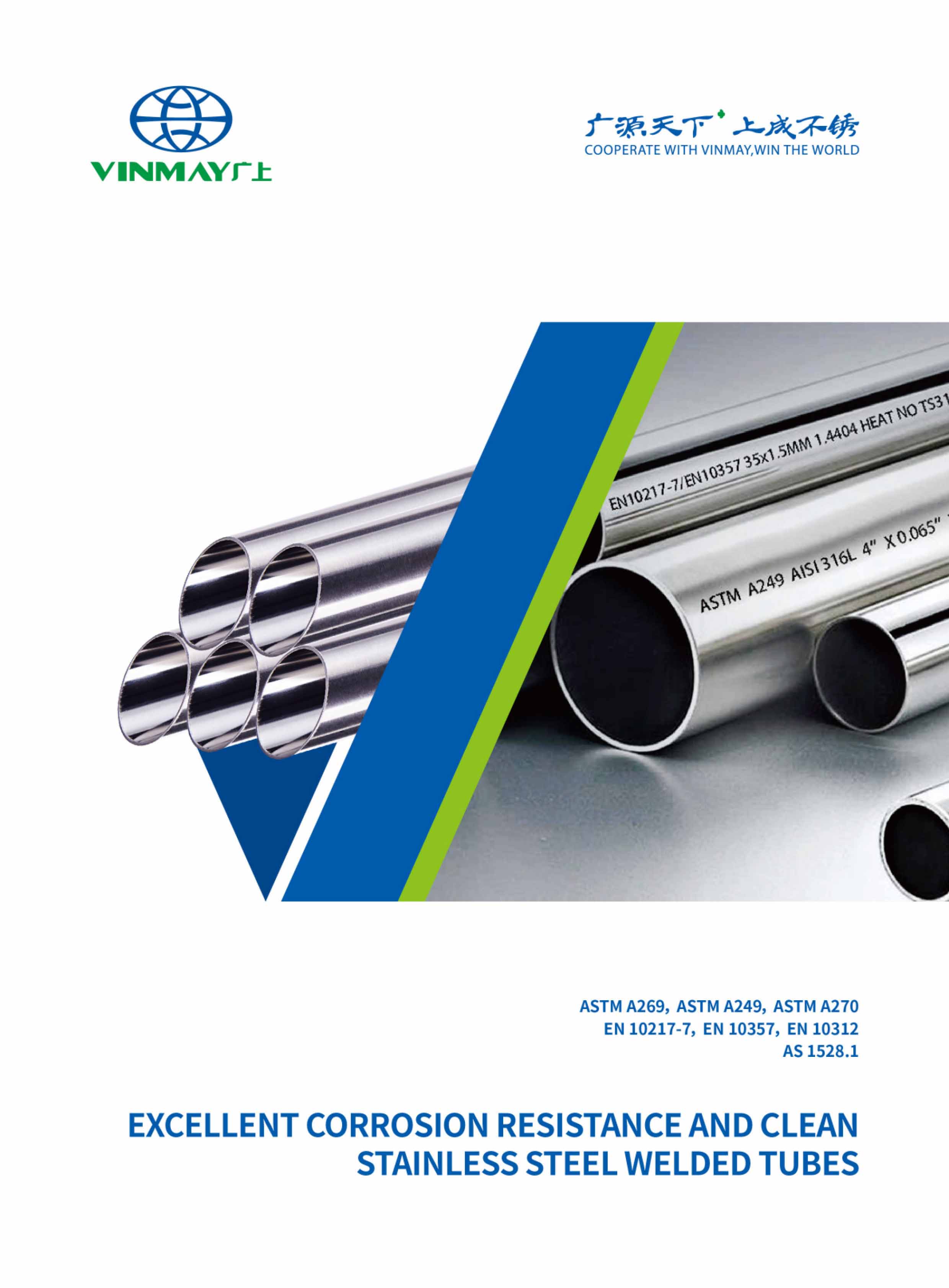Polishing stainless steel pipes entails a methodical process to achieve a pristine, mirror-like finish. The process begins with surface preparation to remove contaminants, followed by pre-grinding to eliminate imperfections. Understanding how to polish stainless steel pipe naturally is crucial, as it involves using eco-friendly methods and materials that avoid harsh chemicals. Pre-polishing uses specific grit belts and compounds to smoothen the surface. Final polishing employs buffing wheels with various compounds, applying medium pressure for a flawless shine. Essential tools include grinders, polishers, and dedicated abrasive belts to prevent cross-contamination. Maintaining the polished surface involves regular wiping with a microfiber cloth and avoiding abrasive cleaners. Understanding these steps can guarantee a high-quality, visually appealing stainless steel pipe finish.
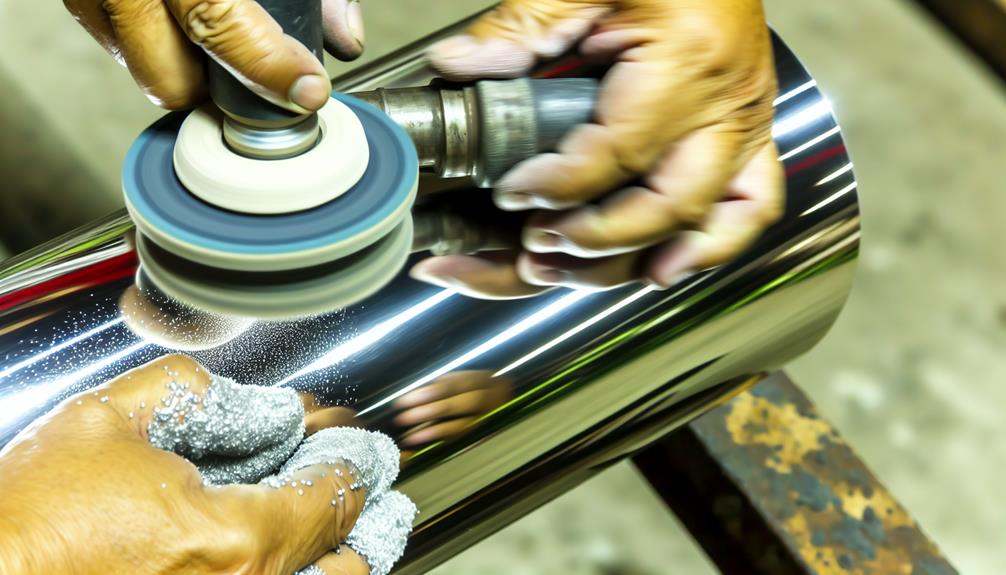
Polishing, in the context of metalworking, refers to the meticulous process of refining a metal surface to achieve a smooth, reflective finish. This procedure involves several polishing techniques designed to eliminate surface imperfections and enhance the metal's aesthetic and functional qualities.
Surface preparation is an initial step of utmost importance, guaranteeing that the stainless steel pipe is free from contaminants. This stage typically involves cleaning the surface with warm water and dish soap, followed by drying with a clean towel. Effective surface preparation is crucial for the subsequent application of polishing compounds and achieving a mirror finish.
Various polishing compounds, each with distinct abrasive properties, play a pivotal role in this process. These compounds, applied using PTX Felt Belts, progressively refine the surface, removing scratches and producing a high-gloss finish. For optimal results, it is essential to use separate Felt Belts for each type of compound to avoid cross-contamination.
Maintenance tips are equally significant to sustain the quality of the polished finish. Regularly wiping the surface with a microfiber cloth to remove residue and ensuring that each polishing compound has its dedicated belt are vital practices. These steps collectively ensure a durable and visually appealing mirror finish on stainless steel pipes.
Achieving different levels of finish on stainless steel pipes demands an understanding of the specific characteristics and applications of each type. Each finish—brushed, satin, and mirror—serves distinct purposes and requires tailored finishing techniques to meet industry standards.
Implementing these finishes requires an in-depth understanding of abrasive selection and surface smoothness. By applying the appropriate polishing methods, professionals can ensure that each stainless steel pipe meets its intended functional and aesthetic requirements, thereby maintaining stringent industry standards.
See Also - Brushed Finish Vs. Satin Finish Stainless Steel Pipe
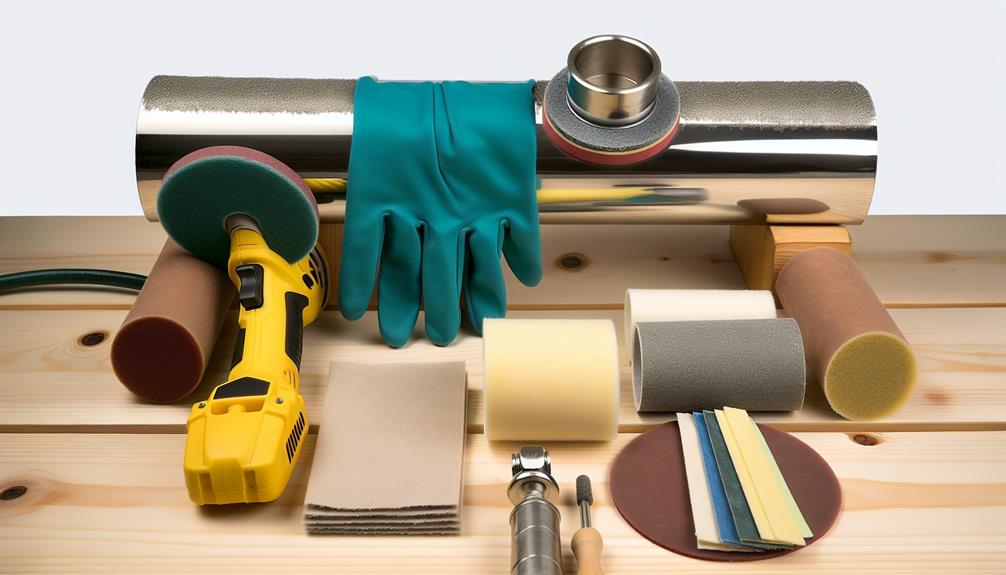
Understanding the different levels of finish is crucial to perfecting the polish on stainless steel pipes. The meticulous selection of tools and materials plays a pivotal role in achieving a mirror-like finish. Key components include grinders, polishers, various belts, and discs—each chosen based on the specific stage of the polishing process.
| Tool Selection | Material Preparation | Grinding Techniques |
|---|---|---|
| PTX Eco Smart 47002 | Pre-grind with Plantex | Utilize 40 grit belt for |
| Varilex Tool 65000A | Flap Disc 93526 | initial grinding |
| PTX Grinding Belt Roller | Intermediate grinding with | Apply consistent pressure |
| PTX TZ-Pyramid Belts | PTX TZ-Pyramid Belts | with 320-600 grit belts |
| PTX Felt Belts | Polishing compounds | Cross-polish at 90 degrees |
Proper material preparation is vital. Begin with pre-grinding using a Plantex Flap Disc (60 grit) and progress through a series of PTX TZ-Pyramid Belts (320 to 2000 grit) for intermediate grinding. Safety precautions must be followed diligently; always use appropriate safety gear to reduce risks.
For effective polishing methods, use separate PTX Felt Belts for each polishing compound and apply pastes and creams exclusively to the PTX Felt Belt. Finally, make sure to remove compound residues with PTX Lime powder to maintain cleanliness and quality. This structured approach guarantees a controlled, high-quality finish on stainless steel pipes.
In the pursuit of achieving a mirror finish on stainless steel pipes, a methodical approach is essential, beginning with meticulous surface preparation. This process entails sequential stages of pre-grinding, intermediate grinding, pre-polishing, and final polishing, each utilizing specific tools and abrasives such as PTX Eco Smart 47002 and PTX TZ-Pyramid Belts. By adhering to these precise steps, the resultant surface will exhibit superior reflectivity, durability, and aesthetic appeal.
Surface preparation is a crucial initial phase in the stainless steel pipe polishing process, guaranteeing a flawless final mirror finish. Effective preparation techniques are essential, as they lay the foundation for subsequent polishing steps.
The first task involves evaluating the pipe's surface condition to determine the appropriate finishing levels required. This evaluation will lead the selection of suitable tools and materials necessary for the job.
Tool selection is vital. The use of high-quality abrasives and polishing compounds directly influences the final result. Choose suitable PTX Grinding Belts and Pyramid Belts based on the pipe's initial state and desired finish. Each belt and tool must be matched to specific stages in the polishing process to ensure optimal outcomes.
Key maintenance tips during surface preparation include:
Starting on the pre-grinding stage involves the careful removal of surface imperfections to pave the way for a flawless mirror finish on stainless steel pipes. Initial surface preparation is essential, guaranteeing that subsequent grinding techniques are effective. Utilize a Plantex Flap Disc 93526 (60 grit) and the Varilex tool 65000A to address initial abrasions. Depending on the level of aggressiveness needed, select from PTX Grinding Belts: 49040 (40 grit), 49060 (60 grit), or 49080 (80 grit).
| Grit Level | Tool Required | Application |
|---|---|---|
| 40 | PTX Grinding Belt 49040 | Heavy material removal |
| 60 | PTX Grinding Belt 49060, Plantex Flap Disc | Moderate material removal |
| 80 | PTX Grinding Belt 49080 | Fine surface preparation before intermediate grinding |
Pre-grinding eliminates deep scratches and surface defects, establishing a uniform base for further refinement. Adopting proper grinding techniques ensures a consistent and even finish. This stage lays the groundwork for the use of polishing compounds in later steps, significantly impacting the final mirror finish. Follow maintenance tips diligently to keep equipment in peak condition and achieve superior results. This methodical approach guarantees that the stainless steel pipe is adequately prepared for the intermediate grinding phase, enhancing the efficiency and outcome of the entire polishing process.
The middle grinding stage is crucial in the mirror polishing process for stainless steel pipes, guaranteeing the transition from pre-grinding to fine polishing is smooth. This phase involves the use of PTX TZ-Pyramid Belts in varying grits to systematically refine the pipe's surface. Effective grinding techniques are vital to achieve a consistent finish that sets the stage for subsequent polishing stages.
Key steps in middle grinding include:
For best results, adhere strictly to these steps and incorporate regular maintenance tips, such as using a microfiber cloth to remove any grinding dust, ensuring a pristine surface for the final polishing stages.
Moving on to the pre-finishing stage, this crucial step bridges the gap between intermediate grinding and the final mirror finish, ensuring the stainless steel pipe attains a flawless surface. Pre-finishing involves meticulous attention to polishing techniques, belt maintenance, and the use of appropriate polishing compounds. Begin by selecting the PTX TZ-Pyramid Belt 49316 (1200 grit) and 49306 (2000 grit) for this process, ensuring each belt is in peak condition for efficient performance.
Belt selection is crucial; worn-out belts can lead to uneven surfaces. Regular belt maintenance, such as checking for wear and tear and guaranteeing proper storage, is essential. Apply the chosen polishing compounds to dedicated PTX Felt Belts to avoid cross-contamination. Surface cleaning is a necessity before starting pre-finishing to eliminate any remaining particles that could hinder the process.
| Step | Tool/Material | Description |
|---|---|---|
| Belt Selection | PTX TZ-Pyramid Belt | Choose 1200 and 2000 grit belts |
| Belt Maintenance | Inspection | Check for wear and proper storage |
| Polishing Compounds | PTX Felt Belts | Apply compounds to dedicated belts |
| Polishing Techniques | Consistent Pressure | Ensure uniform pressure during polishing |
| Surface Cleaning | PTX Lime Powder | Clean residue from previous steps |
Attention to these details guarantees a smooth progression to the final polishing stage, setting a foundation for achieving a mirror-like finish.
Having meticulously prepared the surface through the pre-finishing stage, attention now shifts to the final polishing process to achieve a flawless, mirror-like finish on stainless steel pipes. The objective is to employ precise buffing techniques and high-quality polishing compounds to achieve superior reflectivity and surface maintenance.
Start by using a hard-treated sisal buffing wheel with a black polishing compound. Apply medium pressure, guaranteeing the removal of orange peel, grinding marks, and scratches. This stage sets the foundation for a uniform finish.
Next, switch to a denim or color-stitched buffing wheel with a green polishing compound. Buff with medium pressure to eliminate any remaining dullness, progressively enhancing the pipe's shine.
Consistently maintaining the highest quality, the final inspection and cleaning phase is vital in the stainless steel pipe polishing process. This critical step involves a thorough inspection process to identify any imperfections that may compromise the mirror finish or overall surface cleanliness.
Begin with an exhaustive visual and tactile inspection of the pipe. Utilize precision tools to measure surface smoothness and guarantee uniformity. Attention to detail during this phase is crucial for maintaining stringent quality control standards.
Following the inspection, employ appropriate cleaning methods to eliminate any residual polishing compound or debris. Use a dedicated PTX Felt Belt and apply PTX Lime powder to remove compound residue effectively. This step is essential for achieving the desired surface cleanliness and preparing the pipe for final touch-ups.
For final touch-ups, re-polish any areas identified during the inspection that do not meet the required mirror finish standards. Implementing these finishing touches assures a flawless, high-reflectivity surface.
Post-processing involves a final inspection to verify all standards are met. By adhering to meticulous polishing techniques and cleaning protocols, the integrity and aesthetic appeal of the stainless steel pipe are maintained, culminating in a superior finished product.
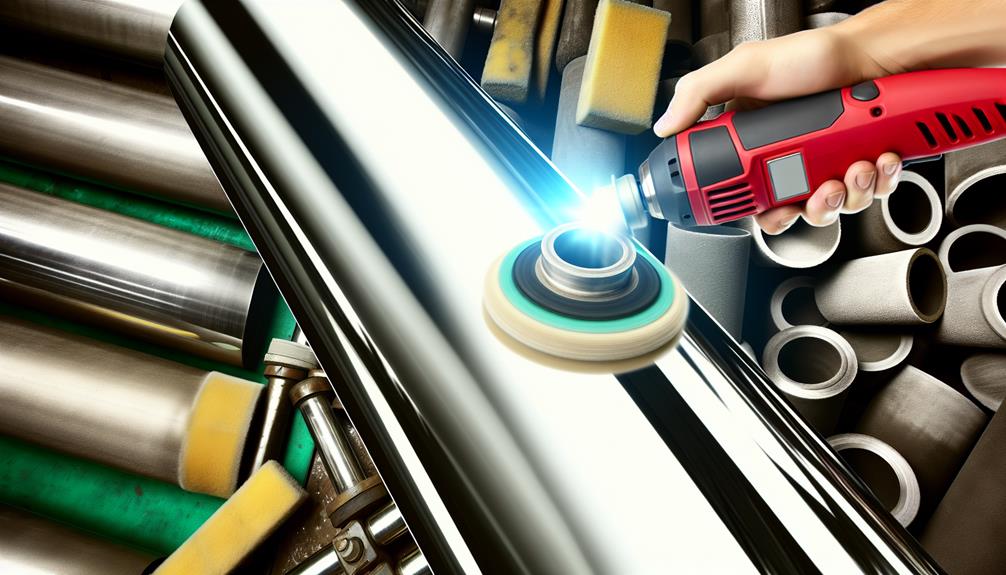
Achieving an ideal finish on stainless steel pipe, whether it’s a polished stainless steel round tube or polished stainless steel square tubing, demands meticulous attention to detail and adherence to industry best practices. The polishing process is a multi-step procedure that requires precision and expertise to secure a mirror-like surface. Proper surface preparation is essential; begin by thoroughly cleaning the pipe to eliminate any contaminants that could interfere with the polishing process.
To enhance your results, consider these key grinding tips and mirror finish techniques:
Incorporate maintenance guidelines to preserve the finish, such as using a microfiber cloth to wipe off residue and prevent scratches. Regularly inspect and replace worn-out abrasive belts and polishing compounds to maintain peak performance. By adhering to these principles, you can achieve a flawless, mirror-like finish that meets the highest industry standards.
One of the frequent pitfalls in refining stainless steel pipe is insufficient surface preparation, which can undermine the entire finishing process. Common mistakes such as overlooking initial cleaning or skipping grit levels during grinding can result in subpar outcomes. Proper surface preparation is essential to remove contaminants and guarantee smooth shifts between abrasive stages.
A critical error involves not adhering to systematic polishing techniques. Each step, from pre-grinding to final polishing, must be meticulously executed. For example, failing to use the correct PTX TZ-Pyramid Belts in sequence (e.g., 320 grit, 400 grit, 600 grit) can prevent achieving perfection. Additionally, inconsistent pressure application or incorrect tool speeds can create uneven surfaces and residual scratches.
Maintenance tips are equally crucial to avoid cross-contamination. Always use dedicated PTX Felt Belts for each polishing compound and never mix different compounds on the same belt. This practice ensures the integrity of each polishing phase and prevents unwanted residues.
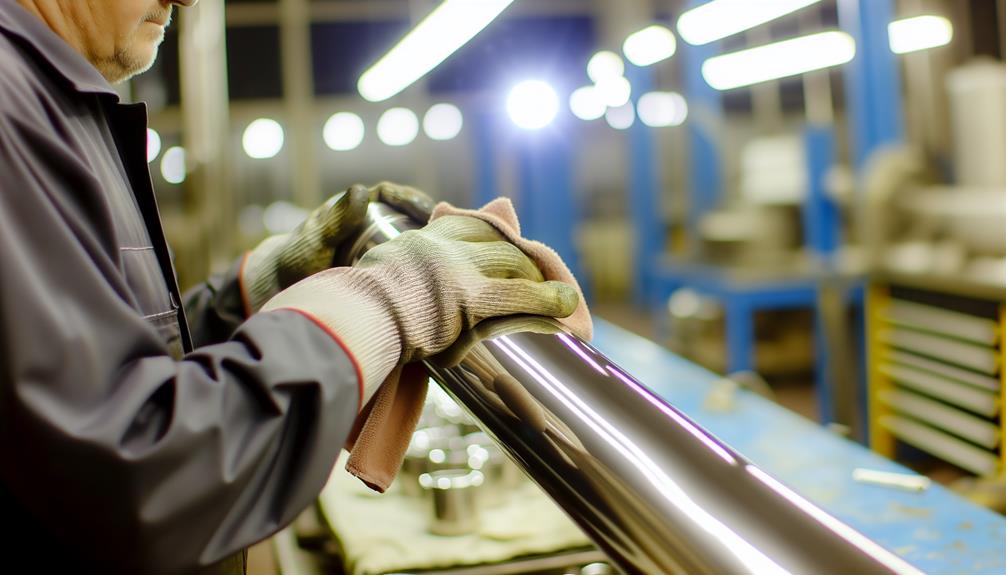
In maintaining the pristine appearance and durability of polished stainless steel pipes, it's essential to implement a rigorous and methodical maintenance regime. Regular surface care is vital to preserving the mirror finish and achieving long-term performance. Below are essential maintenance tips:
Adhering to these maintenance tips will not only extend the lifespan of stainless steel pipes but also preserve their aesthetic appeal and functional integrity. By following these detailed surface care and polishing maintenance protocols, professionals can maintain control over the condition and appearance of their stainless steel installations.
Polished stainless steel pipes can indeed be used in food-grade applications, provided they meet stringent sanitary standards. Their enhanced surface smoothness, superior corrosion resistance, effective cleaning methods, and minimal maintenance requirements make them ideal for such environments.
Recommended: Stainless Steel Pipe Applications in Various Industries
Polishing enhances surface smoothness and aesthetic appeal while maintaining metal strength and welding compatibility. It improves corrosion resistance, important for longevity and reliability in demanding environments. Proper techniques guarantee structural integrity is preserved during the finishing process.
Current Question: Polishing compounds and pastes can lead to chemical exposure, improper waste disposal, water pollution, and reduced air quality. Health risks also arise from inhalation or dermal contact, necessitating stringent safety protocols and environmental management practices.
Proper ventilation combined with eye protection is essential in polishing stainless steel pipes. Additionally, always use protective gloves, avoid flammable materials, and achieve excellent results by maintaining safety and performance.
The mirror finish on stainless steel pipes, under normal use conditions, typically lasts several months. Durability expectations depend on consistent maintenance frequency, including proper cleaning techniques and surface protection. Regularly following maintenance tips guarantees long-lasting aesthetic appeal.
Achieving a mirror finish on stainless steel pipes demands meticulous attention to detail and the precise application of specialized tools and materials. By adhering to systematic steps—ranging from initial cleaning to progressive grinding, polishing, and buffing—a superior reflective surface is attained. At Vinmay, we specialize in providing high-quality stainless steel products designed to meet the most exacting standards. Employing consistent methods and proper upkeep guarantees longevity and luster, akin to a well-tuned symphony of industrial excellence. This thorough approach not only enhances aesthetic appeal but also strengthens the material's resilience against oxidation and rust.
If you're looking to achieve the perfect finish on your stainless steel pipes, trust Vinmay for all your stainless steel needs. Contact Vinmay today to learn more about our products and services.


